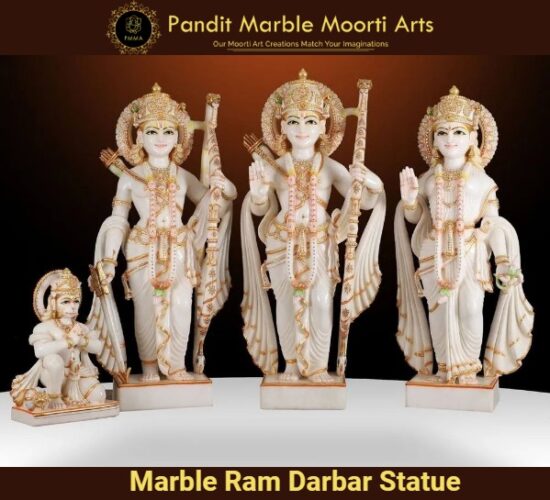A Marble Ram Darbar Statue is a sculpture made from marble depicting the Hindu deities Lord Rama, his wife Sita, his brother Lakshmana, and his devotee Hanuman together, collectively known as the Ram Darbar. The statue is typically carved by skilled artisans and can vary in size from small to life-size or larger. It is a popular item of worship and decoration in Hindu households and temples. The intricate detailing and craftsmanship of the statue make it a beautiful and valuable piece of art.
This statue is made of white marble and has intricate details that showcase the rich cultural and artistic heritage of India. In this article, we will explore the history, significance, and iconography of the magnificent Marble Ram Darbar Statue.
History Of Marble Ram Darbar Statue
The Marble Ram Darbar Statue is a significant piece of art that has a long history in India. It is a depiction of Lord Ram, his wife Sita, his brother Lakshman, and his devotee Hanuman, who are all important figures in Hindu mythology.
The tradition of creating marble sculptures of gods and goddesses has been a part of Indian art for centuries. The Ram Darbar Statue is believed to have been created during the reign of the Mughal emperor Akbar in the 16th century.
During this time, there was a great fusion of Indian and Islamic art, and the Ram Darbar Statue is an excellent example of this. The statue is made of white marble and is carved in exquisite detail. It stands at a height of over six feet and is considered one of the finest examples of Mughal-era marble sculpture.
The Ram Darbar Statue is believed to have been commissioned by Akbar himself, who was known for his love of art and patronage of artists. The statue was created by a team of skilled artisans who worked tirelessly to create a masterpiece that would last for centuries.
Over the years, the statue has been cared for by various rulers and individuals who recognized its importance. It has been moved from place to place, and today, it is housed in the National Museum in New Delhi, where it is on display for all to see.
The Ram Darbar Statue is not just a beautiful piece of art, but it also has great cultural and religious significance. It is a symbol of the devotion of Lord Ram and his followers and is revered by millions of Hindus around the world.
The Significance Of Marble Ram Darbar Statue
The Marble Ram Darbar Statue holds great significance in Hindu mythology and is an important symbol of devotion for millions of people around the world. Here are some of the reasons why the statue is so significant:
Representation Of Lord Ram:
Lord Ram is one of the most revered gods in Hinduism and is considered to be the seventh incarnation of Lord Vishnu. The Marble Ram Darbar Statue depicts Lord Ram in all his glory, symbolizing his strength, courage, and righteousness.
Depiction Of Important Figures:
The statue also depicts Lord Ram’s wife Sita, his brother Lakshman, and his devotee Hanuman, all of whom are important figures in Hindu mythology. Together, they represent loyalty, devotion, and selflessness.
Cultural Heritage:
The statue is an important part of India’s cultural heritage and is a testament to the country’s rich artistic traditions. It is considered to be one of the finest examples of Mughal-era marble sculpture and is admired for its intricate details and exquisite craftsmanship.
Symbol Of Devotion:
The Marble Ram Darbar Statue is a symbol of devotion for millions of Hindus around the world. It represents their faith in Lord Ram and their dedication to his teachings of righteousness, compassion, and selflessness.
Historical Significance:
The statue was created during the reign of the Mughal emperor Akbar, who was known for his love of art and his patronage of artists. It is believed to have been commissioned by Akbar himself and is a testament to the cultural fusion that occurred during his reign.
Overall, the Marble Ram Darbar Statue is an important symbol of Hindu mythology, India’s cultural heritage, and the devotion of millions of people around the world. It serves as a reminder of the importance of faith, loyalty, and selflessness in one’s life.
Iconography Of Marble Ram Darbar Statue
The Marble Ram Darbar Statue is an iconic depiction of Lord Ram, his wife Sita, his brother Lakshman, and his devotee Hanuman. Each of these figures has a specific iconography that is represented in the statue.
Lord Ram is depicted as a warrior king, standing tall and proud with his bow in hand. He wears a crown and a robe, and his face is serene and calm. He is often depicted with a quiver of arrows at his back, symbolizing his readiness to defend his kingdom.
Sita, Ram’s wife, is depicted with a calm and serene expression. She is often shown with her hands clasped in prayer, representing her devotion to her husband and her faith in God. She wears a simple sari and a necklace, and her hair is tied in a bun.
Lakshman, Ram’s brother, is depicted as a warrior, like his brother. He stands beside Ram, holding a bow and arrow and wearing a crown and robe. His face is also calm and serene, representing his dedication to his brother and his loyalty to his kingdom.
Hanuman, the monkey god and Ram’s faithful servant, is depicted kneeling at Ram’s feet. He is shown with a monkey face and a muscular body, and his hands are clasped in prayer. He is often depicted wearing a loincloth and a necklace of pearls.
Overall, the Marble Ram Darbar Statue is a beautiful representation of Hindu mythology and is an important symbol of devotion for millions of people around the world. Its intricate details and exquisite craftsmanship make it a true masterpiece of Indian art.









